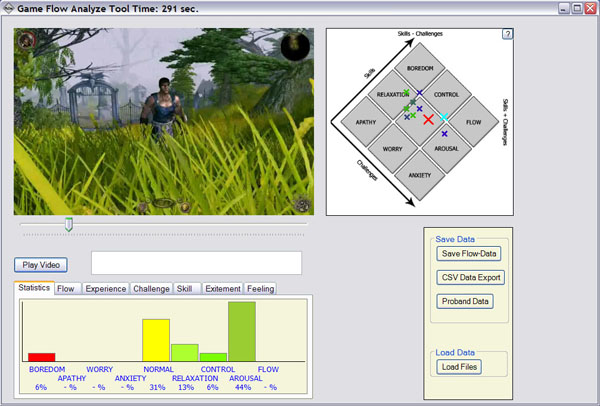Computer games & Flow
Usually it takes an investment of several millions of dollars and one to two years of development time to create and ship a commercial computer game. And that game has to sell very well within a few weeks after its release, before potential buyers focus their attention to other titles. Admittedly, publishers can prolong a game's life cycle by releasing add-ons, but the pressure developers face because of a game's sheer scope and its development costs is still enormous. That is the reason why many game developers can't afford a 'flop'. Consequently, innovative ideas don't find their way into games and proven concepts get re-used and tweaked instead.
A new game based on innovative, never-before-seen game concepts runs the risk of finding only few or even no buyers at all, because at the time of its release it neither appeals to the gamers' taste nor the zeitgeist. Still, that risk could be reduced considerably by making use of the flow phenomenon early in the development process and letting potential buyers test a game's concept for its actual playability. It is also important to ask yourself: What is the best way to test games and gauge their potential success?
Flow
After playing their favorite games players often say they forgot time and their surroundings, because they were completely immersed in the game. Other activities such as mountaineering and playing music can have the same effect. US sociologist Mihaly Csikszentmihalyi did some research on that phenomenon, and in 1965 he coined the term "flow". "Flow" means total immersion in an activity. If a person experiences flow, their emotions, their will and their thoughts harmonize in such a way that, to them, time becomes irrelevant, and they can perform their current activity effortlessly.
Since emotional conditions are hard to measure, many studies on flow used to be based on questionnaires: test persons are interrupted in their activities and asked to answer a few questions on their different emotional states. However, questionnaires lend themselves mainly for activities that can be interrupted without affecting the flow (i.e. activities including pauses such as football matches with their half-time breaks). Computer and video games require a different approach, because any interruption of the player's game experience will also impact the flow.
Conclusion: The classical questionnaire approach only lends itself to interviews after the actual game play experience. While it is possible to determine whether players experienced flow using that way, it will remain uncertain when exactly that flow began and how long it lasted.
Diploma Thesis: Flow Measuring System
n 2005, as part of my diploma thesis, I developed a new method for measuring flow, which is also suitable for computer and video games. My approach combined two methods: interruption-free questionnaires and automatic flow measurement. The interruption-free questionnaire method included a complete video recording of the activity, thanks to which flow experiences could be captured continuously. Using the video material, data capture took place right after the recording of the game.
Automatic flow measurement covered both heart activity and skin resistance. Simultaneously, the on-screen action and the player's face were captured on video for later analysis. All that data was time-synced and helped calculating the flow values automatically. Both heart activity and skin resistance served as stress indicators for the test person, and their facial expression was supposed to help interpreting their emotional condition. Since no software for capturing facial expressions was available when I was working on my diploma thesis, a fully automatic flow measurement was impossible and only stress areas could be calculated automatically.
Implementation problems
Actually using the automatic flow measurement system in practice was not an easy task. For a start, test persons needed to be wired extensively, and then you needed two simultaneously video recordings. The task of syncing both data recordings alone required a lot of manual tweaking.
Capturing facial expressions was another problem. Analysis of the video footage recorded over several sessions showed that test persons hardly ever changed their facial expressions at all. Usually they appeared to be focused and showed little signs of emotion. Online videos of the capturing systems for facial expressions available at that time showed that those systems responded to significant changes of the expression only, making them rather unsuitable for this method of measuring flow automatically.
Because of all those findings, I consider the method of automatic flow measurement to be impracticable at the moment. Therefore, questionnaires are the only remaining method for measuring flow.
How the Game Flow Analysis Tool works

With the Game-Flow-Analysis-Tool you can capture a player's flow experience using a combination of video recordings and questionnaires and then analyse the data. During the analysis you can reconstruct the course of the game with the help of the player's reactions and detect possible flaws in the game's design. Using a statistical evaluation of the player's emotional conditions you create a basis for comparisons. Then you can conduct target audience tests and evaluate of the quality of the game (i.e. level segments) based on the data you compiled earlier on. Captured data and measurement results are stored in a .csv file, which you can then analyse using any spread sheet software.

